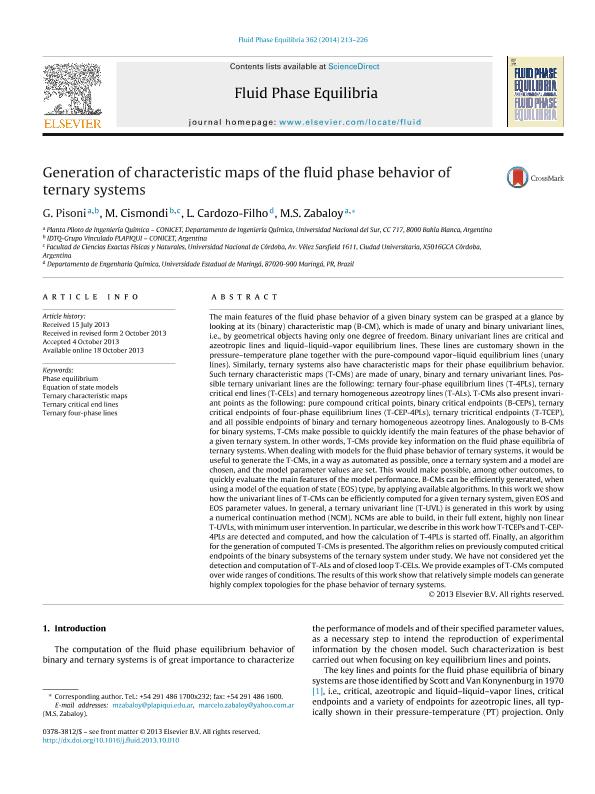Artículo
Generation of characteristic maps of the fluid phase behavior of ternary systems
Fecha de publicación:
07/2013
Editorial:
Elsevier Science
Revista:
Fluid Phase Equilibria
ISSN:
0378-3812
Idioma:
Inglés
Tipo de recurso:
Artículo publicado
Clasificación temática:
Resumen
The main features of the fluid phase behavior of a given binary system can be grasped at a glance by looking at its (binary) characteristic map (B-CM), which is made of unary and binary univariant lines, i.e., by geometrical objects having only one degree of freedom. Binary univariant lines are critical and azeotropic lines and liquid–liquid–vapor equilibrium lines. These lines are customary shown in the pressure–temperature plane together with the pure-compound vapor–liquid equilibrium lines (unary lines). Similarly, ternary systems also have characteristic maps for their phase equilibrium behavior. Such ternary characteristic maps (T-CMs) are made of unary, binary and ternary univariant lines. Possible ternary univariant lines are the following: ternary four-phase equilibrium lines (T-4PLs), ternary critical end lines (T-CELs) and ternary homogeneous azeotropy lines (T-ALs). T-CMs also present invariant points as the following: pure compound critical points, binary critical endpoints (B-CEPs), ternary critical endpoints of four-phase equilibrium lines (T-CEP-4PLs), ternary tricritical endpoints (T-TCEP), and all possible endpoints of binary and ternary homogeneous azeotropy lines. Analogously to B-CMs for binary systems, T-CMs make possible to quickly identify the main features of the phase behavior of a given ternary system. In other words, T-CMs provide key information on the fluid phase equilibria of ternary systems. When dealing with models for the fluid phase behavior of ternary systems, it would be useful to generate the T-CMs, in a way as automated as possible, once a ternary system and a model are chosen, and the model parameter values are set. This would make possible, among other outcomes, to quickly evaluate the main features of the model performance. B-CMs can be efficiently generated, when using a model of the equation of state (EOS) type, by applying available algorithms. In this work we show how the univariant lines of T-CMs can be efficiently computed for a given ternary system, given EOS and EOS parameter values. In general, a ternary univariant line (T-UVL) is generated in this work by using a numerical continuation method (NCM). NCMs are able to build, in their full extent, highly non linear T-UVLs, with minimum user intervention. In particular, we describe in this work how T-TCEPs and T-CEP-4PLs are detected and computed, and how the calculation of T-4PLs is started off. Finally, an algorithm for the generation of computed T-CMs is presented. The algorithm relies on previously computed critical endpoints of the binary subsystems of the ternary system under study. We have not considered yet the detection and computation of T-ALs and of closed loop T-CELs. We provide examples of T-CMs computed over wide ranges of conditions. The results of this work show that relatively simple models can generate highly complex topologies for the phase behavior of ternary systems.
Archivos asociados
Licencia
Identificadores
Colecciones
Articulos(CCT - BAHIA BLANCA)
Articulos de CTRO.CIENTIFICO TECNOL.CONICET - BAHIA BLANCA
Articulos de CTRO.CIENTIFICO TECNOL.CONICET - BAHIA BLANCA
Articulos(PLAPIQUI)
Articulos de PLANTA PILOTO DE INGENIERIA QUIMICA (I)
Articulos de PLANTA PILOTO DE INGENIERIA QUIMICA (I)
Citación
Pisoni, Gerardo Oscar; Cismondi Duarte, Martín; Cardozo Filho, Lucio; Zabaloy, Marcelo Santiago; Generation of characteristic maps of the fluid phase behavior of ternary systems; Elsevier Science; Fluid Phase Equilibria; 362; 7-2013; 213-226
Compartir
Altmétricas




